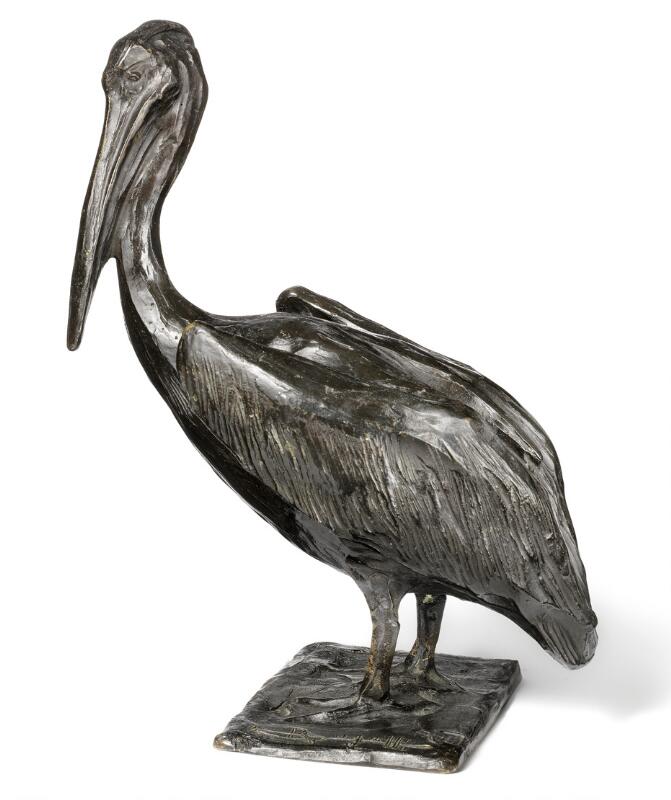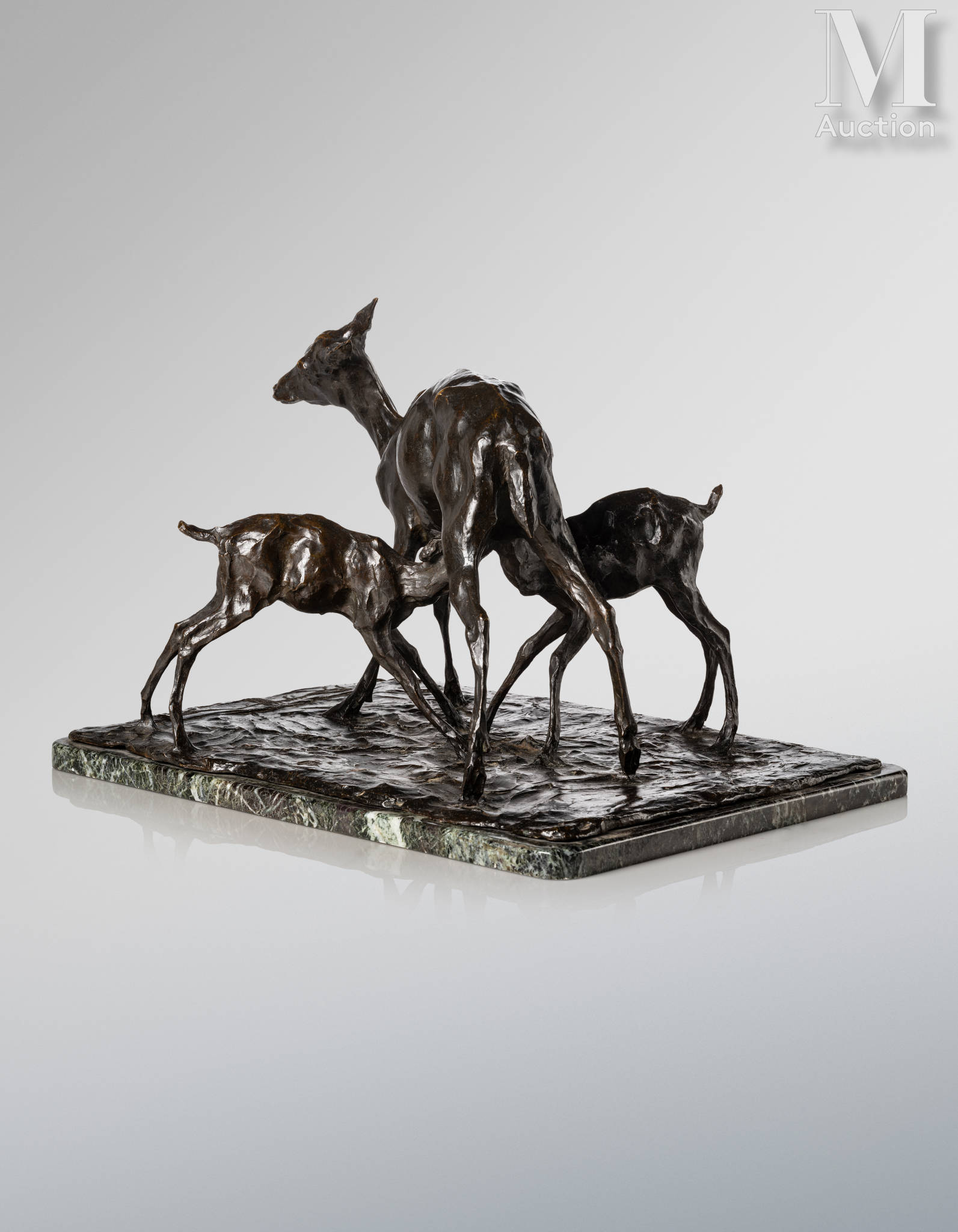Rembrandt Bugatti (b. Milan 1884, d. Paris 1916) “Pelican en conversation”, 1906. Signed R. Bugatti with foundry stamp “Cire perdue A.A. Hébrard” and stamped (10). Bronze with brown patina. H. 23.5 cm. Original plaster version executed 1905–1906; this bronze cast during the artist's lifetime. Literature: M. Harvey: “The bronzes of Rembrandt Bugatti (1885–1916)”, 1979, p. 77 (another cast ill.) Literature: P. Dejean: “Bugatti”, New York, 1982, p. 170 (another cast ill.) Literature: J.C. and V.F. Des Cordes: “Rembrandt Bugatti, Catalogue”, p. 140 (another cast ill.) Provenance: Private collection, Denmark. Already as a young man, Rembrandt Bugatti found the vision and style that would characterize his art for the rest of his far too short life: animal motifs that were used both for their own sake, but at the same time as an expression of emotions and a celebration of the aesthetic form. Bugatti was born in Milan in 1884, and as the son of furniture designer Carlo Bugatti and younger brother of the ground-breaking car designer Ettore Bugatti a strong creative vein ran in the family around him right from the start. The father had a huge influence on Rembrandt’s talent, but the shy Bugatti turned his gaze to the world of zoology, where his introverted mind found both understanding, peace and room for contemplation. Bugatti regularly visited the zoos at the Jardin des Plantes in Paris and Antwerp, and he always modelled his works directly in front of the animals that were his motifs. With empathy and precision, he captured their individual behaviour and special characteristics, and today he stands as one of the most empathetic and finest “animaliers”. Bugatti knew the grandeur of the animal bronzes of the Renaissance, the classical reliefs of Greece and Rome, and the mythical horses on the facade of the St Mark Basilica in Venice. He also knew of the 'revival' of animal subjects of the nineteenth century, which was ushered in by sculptors such as Barye and Emmanuel Frémiet as well as painters such as Eugène Delacroix Jean Louis Géricault and George Stubbs Unlike his predecessors within the genre, who primarily worked in the studio based on photographs or drawings, Bugatti took a step closer to his models. He spent whole days on his intense observations and often interacted physically with the animals. Using plastilina – a new and more flexible wax-based material that didn't harden like plaster – Bugatti created his expressive sculptures in situ with enormous skill, ingenuity and technical finesse. At the age of thirty-one, Bugatti had established a large and varied oeuvre with about 300 sculptures, but despite great recognition and success – he participated in the Venice Biennale before turning twenty – Bugatti's career was brutally cut short in January 1916, where he committed suicide in his studio on Montparnasse. The horrors of World War I and the resulting unshakable experiences as a volunteer paramedic, had plunged him into an abysmal depression, further exacerbated by economic difficulties and illness. After his death, he slipped into oblivion, hidden in his brother's heavy shadow, and the Bugatti name was for years exclusively synonymous with cars. Although his work can be found in the world's largest museums and is highly valued by collectors, Bugatti has only recently begun to be widely recognized and incorporated into the narrative of 20th century art history. Bugatti's style is vital and expressive, with stylistic references to the many artistic innovations of the time – Impressionism, Expressionism, Cubism and Futurism – but at the same time completely and utterly unique. At the auction, we have the honour of offering the work “Pelican en conversation” from 1904. During this period, Bugatti painted the pelican from different angles and during different situations, but the version here is a telling one. Bugatti has not highlighted or stylized the bird's plumage, but by using shadings and fingerprints he creates a vibr
Condition
Rembrandt Bugatti (b. Milan 1884, d. Paris 1916) “Pelican en conversation”, 1906. Signed R. Bugatti with foundry stamp “Cire perdue A.A. Hébrard” and stamped (10). Bronze with brown patina. H. 23.5 cm. Original plaster version executed 1905–1906; this bronze cast during the artist's lifetime. Literature: M. Harvey: “The bronzes of Rembrandt Bugatti (1885–1916)”, 1979, p. 77 (another cast ill.) Literature: P. Dejean: “Bugatti”, New York, 1982, p. 170 (another cast ill.) Literature: J.C. and V.F. Des Cordes: “Rembrandt Bugatti, Catalogue”, p. 140 (another cast ill.) Provenance: Private collection, Denmark. Already as a young man, Rembrandt Bugatti found the vision and style that would characterize his art for the rest of his far too short life: animal motifs that were used both for their own sake, but at the same time as an expression of emotions and a celebration of the aesthetic form. Bugatti was born in Milan in 1884, and as the son of furniture designer Carlo Bugatti and younger brother of the ground-breaking car designer Ettore Bugatti a strong creative vein ran in the family around him right from the start. The father had a huge influence on Rembrandt’s talent, but the shy Bugatti turned his gaze to the world of zoology, where his introverted mind found both understanding, peace and room for contemplation. Bugatti regularly visited the zoos at the Jardin des Plantes in Paris and Antwerp, and he always modelled his works directly in front of the animals that were his motifs. With empathy and precision, he captured their individual behaviour and special characteristics, and today he stands as one of the most empathetic and finest “animaliers”. Bugatti knew the grandeur of the animal bronzes of the Renaissance, the classical reliefs of Greece and Rome, and the mythical horses on the facade of the St Mark Basilica in Venice. He also knew of the 'revival' of animal subjects of the nineteenth century, which was ushered in by sculptors such as Barye and Emmanuel Frémiet as well as painters such as Eugène Delacroix Jean Louis Géricault and George Stubbs Unlike his predecessors within the genre, who primarily worked in the studio based on photographs or drawings, Bugatti took a step closer to his models. He spent whole days on his intense observations and often interacted physically with the animals. Using plastilina – a new and more flexible wax-based material that didn't harden like plaster – Bugatti created his expressive sculptures in situ with enormous skill, ingenuity and technical finesse. At the age of thirty-one, Bugatti had established a large and varied oeuvre with about 300 sculptures, but despite great recognition and success – he participated in the Venice Biennale before turning twenty – Bugatti's career was brutally cut short in January 1916, where he committed suicide in his studio on Montparnasse. The horrors of World War I and the resulting unshakable experiences as a volunteer paramedic, had plunged him into an abysmal depression, further exacerbated by economic difficulties and illness. After his death, he slipped into oblivion, hidden in his brother's heavy shadow, and the Bugatti name was for years exclusively synonymous with cars. Although his work can be found in the world's largest museums and is highly valued by collectors, Bugatti has only recently begun to be widely recognized and incorporated into the narrative of 20th century art history. Bugatti's style is vital and expressive, with stylistic references to the many artistic innovations of the time – Impressionism, Expressionism, Cubism and Futurism – but at the same time completely and utterly unique. At the auction, we have the honour of offering the work “Pelican en conversation” from 1904. During this period, Bugatti painted the pelican from different angles and during different situations, but the version here is a telling one. Bugatti has not highlighted or stylized the bird's plumage, but by using shadings and fingerprints he creates a vibr
Condition















Try LotSearch and its premium features for 7 days - without any costs!
Be notified automatically about new items in upcoming auctions.
Create an alert